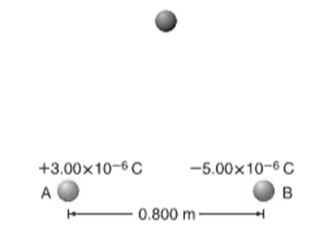
the magnitude and the direction of the electric field strength at a point above the x axis.
Answer to Problem 102A
The magnitude of the electric field is
Explanation of Solution
Given:
Charge of the sphere A is
Charge of the sphere B is
Separation between the sphere A and B is 0.800 m.
The given figure is shown below:

Formula used:
The magnitude of the force on the charge
Here,
Electric field strength can be expressed as
Calculation:
The electric field strength at a point due to two charges can be calculated by taking the vector sum of the electric fields due to the charges.
Substitute the value of
Substitute the values of
Since the charge A is positive, the direction of the electric field will be away from the charge.
Now, find the field strength
Substitute the values of
The negative sign indicates that the direction of the electric field is towards the charge B .
The electric field strength
The resultant electric field strength is calculated as
The direction will be towards the negative charge since it has the larger magnitude.
Conclusion:
Hence, magnitude of the electric field is
Chapter 21 Solutions
Glencoe Physics: Principles and Problems, Student Edition
Additional Science Textbook Solutions
Physics for Scientists and Engineers: A Strategic Approach with Modern Physics (4th Edition)
College Physics (10th Edition)
Sears And Zemansky's University Physics With Modern Physics
Physics for Scientists and Engineers: A Strategic Approach, Vol. 1 (Chs 1-21) (4th Edition)
College Physics: A Strategic Approach (3rd Edition)
Essential University Physics: Volume 2 (3rd Edition)
 College PhysicsPhysicsISBN:9781305952300Author:Raymond A. Serway, Chris VuillePublisher:Cengage Learning
College PhysicsPhysicsISBN:9781305952300Author:Raymond A. Serway, Chris VuillePublisher:Cengage Learning University Physics (14th Edition)PhysicsISBN:9780133969290Author:Hugh D. Young, Roger A. FreedmanPublisher:PEARSON
University Physics (14th Edition)PhysicsISBN:9780133969290Author:Hugh D. Young, Roger A. FreedmanPublisher:PEARSON Introduction To Quantum MechanicsPhysicsISBN:9781107189638Author:Griffiths, David J., Schroeter, Darrell F.Publisher:Cambridge University Press
Introduction To Quantum MechanicsPhysicsISBN:9781107189638Author:Griffiths, David J., Schroeter, Darrell F.Publisher:Cambridge University Press Physics for Scientists and EngineersPhysicsISBN:9781337553278Author:Raymond A. Serway, John W. JewettPublisher:Cengage Learning
Physics for Scientists and EngineersPhysicsISBN:9781337553278Author:Raymond A. Serway, John W. JewettPublisher:Cengage Learning Lecture- Tutorials for Introductory AstronomyPhysicsISBN:9780321820464Author:Edward E. Prather, Tim P. Slater, Jeff P. Adams, Gina BrissendenPublisher:Addison-Wesley
Lecture- Tutorials for Introductory AstronomyPhysicsISBN:9780321820464Author:Edward E. Prather, Tim P. Slater, Jeff P. Adams, Gina BrissendenPublisher:Addison-Wesley College Physics: A Strategic Approach (4th Editio...PhysicsISBN:9780134609034Author:Randall D. Knight (Professor Emeritus), Brian Jones, Stuart FieldPublisher:PEARSON
College Physics: A Strategic Approach (4th Editio...PhysicsISBN:9780134609034Author:Randall D. Knight (Professor Emeritus), Brian Jones, Stuart FieldPublisher:PEARSON





